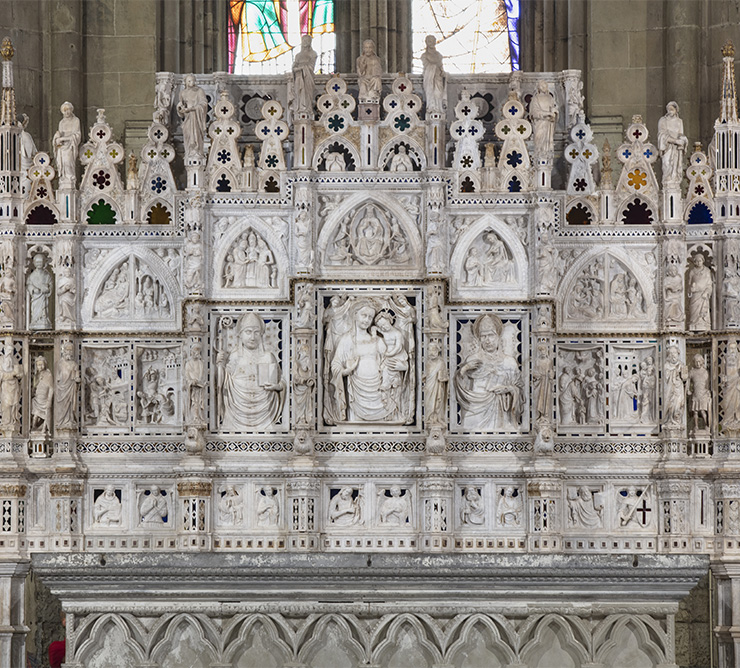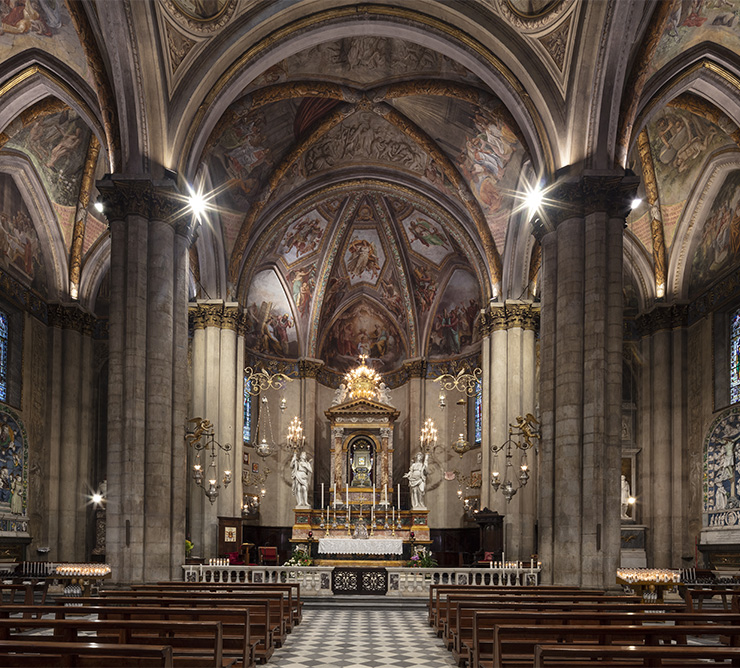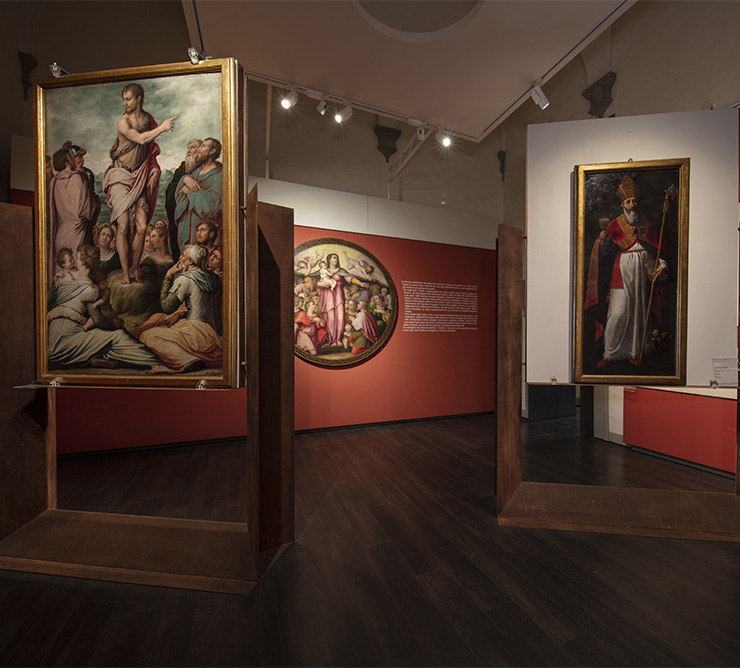La Cattedrale, intitolata ai Santi Pietro e Donato, si affaccia su Piazza del Duomo. Questo imponente edificio cristiano racchiude all’interno di un’armoniosa architettura gotica autentici tesori d’arte, nonché importantissime testimonianze di fede. Di fronte al Duomo sorge il Palazzo Vescovile, che ospita il Museo Diocesano di Arte Sacra.
Il Duomo domina la piazza ergendosi al sommo di un’ampia scalinata che cinge il tempio su due lati. La facciata esterna, rimasta grezza, fu definita nella sua attuale sistemazione tra il 1900 e il 1914 su disegno di Dante Viviani. L’insieme, in cui... more
Il Duomo domina la piazza ergendosi al sommo di un’ampia scalinata che cinge il tempio su due lati. La facciata esterna, rimasta grezza, fu definita nella sua attuale sistemazione tra il 1900 e il 1914 su disegno di Dante Viviani. L’insieme, in cui non mancano dettagli dal gusto liberty, è vivacizzato da un articolato apparato scultoreo. L’interno, a tre navate senza transetto, è caratterizzato da un’abside poligonale. Capolavoro dell’arte vetraria è il ciclo delle sette vetrate del Marcillat, dipinte in due fasi tra il 1516 e il 1524. A lui spetta anche l’esecuzione delle Storie Bibliche dipinte nelle volte delle prime tre campate della navata maggiore e della prima campata della navata laterale sinistra. Monumentale è il complesso dell’Altare Maggiore. L’Arca di San Donato, che custodisce i resti mortali del Santo Patrono d’Arezzo e secondo Vescovo della città, attira gli sguardi per la luminosità del marmo, per le dimensioni e per la pregevolezza del disegno. Nella navata sinistra, accanto alla porta della sacrestia, si può ammirare un capolavoro di Piero della Francesca: la Maddalena, eseguito probabilmente nel 1459, mentre il maestro di Sansepolcro si trovava in città intento a dipingere in San Francesco il ciclo di affreschi della Leggenda della vera Croce. La visita alla Cattedrale ha il suo momento culminante nella cappella della Madonna del Conforto, che si apre lungo la navata sinistra ed è connessa al miracolo del 15 febbraio 1796. Iniziata nell’agosto dello stesso anno, la cappella fu completata nel 1817 ed oggi è fulcro di una forte devozione popolare. Proprio di fronte al Duomo sorge il Palazzo Vescovile, tuttora sede del Vescovo di Arezzo. Fu costruito nel XIII secolo, anche se l’aspetto attuale risale alla fine del Cinquecento, quando l’edificio venne radicalmente ristrutturato con successive aggiunte sei-settecentesche. Dal 2011 ospita in cinque sale al piano terra il Museo Diocesano di Arte Sacra, interessantissima collezione di quadri, sculture, manoscritti miniati, parati e oreficerie provenienti dal territorio della Diocesi, mentre al primo piano sono visitabili la quadreria vescovile e la Camera dei Papi, destinata ad accogliere i pontefici in visita ad Arezzo. Degna di nota è la decorazione del vestibolo, piccolo ambiente destinato all’accoglienza che conserva un ciclo di affreschi che ripercorrono la storia dell’antica Diocesi di Arezzo, dove sono ricordati i Santi principali e i più importanti luoghi di culto del territorio.
lessORARI DUOMO E MUSEO DIOCESANO:
(ultimo ingresso mezz'ora prima della chiusura)
N.B.: gli orari potrebbero variare anche improvvisamente per attività legate alla liturgia
In auto:
Arezzo si raggiunge da Firenze o da Roma tramite l'Autostrada del Sole (A1 Milano-Napoli) uscendo al casello di Arezzo. Da qui sono circa 10 km per raggiungere il centro della città. Vi sono poi le strade statali: la SS 73 con provenienza dalla Valdichiana, Siena, Grosseto e Sansepolcro e la SS 71, Umbro-Casentinese, con provenienza da Cortona, Lago Trasimeno, Perugia.
In treno:
La Stazione Ferroviaria di Arezzo si trova lungo la linea Bologna-Roma. La Stazione è servita da collegamenti giornalieri ad alta velocità e Intercity per Firenze, Roma e il resto d'Italia.

The Ark of San Donato, which holds the mortal rests of Arezzo's patron saint, attracts the visitor's attention due to the brightness of its marble, its size and the exquisiteness of its design. The complex consists of three parts: the altar completed before 1289, the marble altarpiece finely worked in bas-relief bristling with spires and pinnacles and placed on the altar in the second half of the 14th century, and the large ark containing the relics of the Saint and other martyrs of Arezzo. A work of several sculptors, who finished it by 1375, it portrays the Madonna and Child in the centre, while at the sides are St Gregory Pope and St Donato whose body, together with the bodies of St Antilla and other saints, is located under the altar. On the sides of the three central figures are scenes from the life of St Donato, while in the upper register are scenes from the life of the Virgin Mary.
St Donato, born in Nicomedia and moved to Rome as a child, later took refuge in Arezzo to escape persecution against the Christians. He became a bishop and died here, suffering martyrdom in 304 under Diocletian. The oldest hagiographic texts narrate his beheading and the secular cult that the city has paid to its patron, associating him with the title of martyr since the 8th century. For the miracles he has performed and his intense work of evangelisation, he is venerated not only in Arezzo and other Tuscan municipalities, but also in numerous locations in Italy and abroad. His feast day is celebrated on 7 August.
less
The chapel, dedicated to Our Lady of Comfort, was built between 1796 and 1823 to a design by the Florentine architect Giuseppe Del Rosso, and is a notable example of neo-Gothic architecture with neo-classical decoration. After passing through the imposing wrought-iron gate, we are ushered into a sumptuous environment, rich in variegated marble, gilding and vast frescoed surfaces. The majestic room, divided into three naves, was built following a miracle on 15 February 1796.
The small terracotta image that can be seen on the chapel's high altar, depicting the Virgin Mary's bust, was found inside a tavern in the city, near Porta San Clemente. The majolica depiction of the Virgin Mary, blackened by soot from a coal cooker that was under the effigy, was, according to some witnesses, seen to whiten and glow, and the earthquake tremors, which scourged the city in those days, ceased. Bishop Niccolò Marcacci officially declared the prodigy, which was followed by other miracles attributed to the sacred image, which has been called Virgin Mary of Comfort ever since, having consoled the population terrified by the earthquake. The devotion of the people is very much alive, and in 1993 it was declared by John Paul II as the Patron Saint of the Diocese.
less
The centre of Vasari's works in the Museum is well represented by the processional banner painted by the artist for the Compagnia dei Peducci in 1549 and consisting of two highly refined canvases depicting the Preaching of the Baptist and the Baptism of Jesus. The two canvases, characterised by the delicacy of the colours and shading, as well as the sober naturalism of the figures and the profound spirituality of the scene, are unquestionably among the best painted by this Master. Exhibited by the same artist is a tondo depicting the Virgin Mary of Mercy, dated 1557, formerly the sky of a sumptuous canopy that was carried in procession.